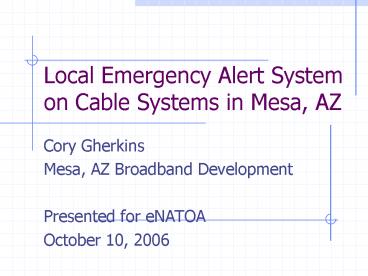Local Emergency Alert System on Cable Systems in Mesa, AZ - PowerPoint PPT Presentation
1 / 16
Title:
Local Emergency Alert System on Cable Systems in Mesa, AZ
Description:
Required to provide Emergency Action Notification messages and regular tests ... Consider less-obtrusive text crawl. Develop plan to program access channel ... – PowerPoint PPT presentation
Number of Views:107
Avg rating:3.0/5.0
Title: Local Emergency Alert System on Cable Systems in Mesa, AZ
1
Local Emergency Alert System on Cable Systems in
Mesa, AZ
- Cory Gherkins
- Mesa, AZ Broadband Development
- Presented for eNATOA
- October 10, 2006
2
Overview
- Federal Emergency Alert System
- Why communities may need a local alert system
- How Mesa negotiated and implemented the system
- Summary
- National considerations
3
National Emergency Alert System (EAS)
- Required in all cable systems
- Required to provide Emergency Action Notification
messages and regular tests - State, local, and weather messages are optional
under Federal law - Transmission can be required in cable franchise
agreement
4
How a locality activates National EAS
- Activation protocol depends on state and local
emergency plans - Direct activation by large cities, counties, and
state authorities - Medium and small cities and counties may not be
able to activate without going through area
emergency authority (such as County) - Local alert can supplement EAS for local
emergencies
5
Local alert system
- Local Override
- All localized hazards and emergencies
- Toxic waste, Columbine, road closure, flash
flood, microburst - Alert to all residents on the cable system by
emergency officials of franchising authority - Video, audio and/or text crawl
- Analog and digital channels
- Can point viewers to access channel for details
- Complement to EAS for local emergencies
- Ideally system is integrated with device used for
EAS - Can prevent collision between alerts, give
priority to EAS
6
Local alert can reach all channels
7
How Mesa negotiated local alert
- Cable operator out of compliance
- Provision for EAS on all channels
- Provision not met for digital channels
- New agreement negotiated
- Cox to work with City to develop technical
solution - Carriage of local alert on analog and digital
channels - Effort to limit alert to City boundaries
- Cox worked with manufacturer and City to plan and
deploy solution - System worked
- Minor technical issues (sound, duration of alert,
carriage on HDTV and DVR) - Cox solved most remaining issues
8
How Mesa implemented local alert
- Second cable operator (Cable America)
- Agreed to same functional system and
implementation plan - Technical implementation different depending on
cable companys equipment - CableAmerica Motorola equipment ? full
screen override - CoxScientific Atlanta ? text crawl
9
Operation of local override
- Emergency official telephones system (local
encoder) - Official enters code for identification
- Local encoder generates EAS format message for
existing EAS system - Detailed information given on access channel or
municipal Web site - Address by officials
- Maps, video of incident, instructions to public
- Integrated with emergency operations center
10
Implementation in Cox System
11
Mesa Channel 11 Override
- City advises viewers of all analog and digital
video stations on cable system to tune to Channel
11 via text crawl or full screen message - City emergency and programming staff can program
Channel 11 content immediately via remote dial-in
and remote e-mail - City programs Channel 11 with emergency audio
message and video text screens - City design uses off-the-shelf PC and Macintosh
hardware and software and dial-up telephone line
12
Mesa Channel 11 Override
13
Local Override Recommendations
- Consult with local emergency staff regarding need
- Assess if EAS is sufficient for your community
- Verify that local override is operational in
existing system - Analog and digital channels
- Consider less-obtrusive text crawl
- Develop plan to program access channel
- Continue periodic testing by emergency officials
14
Periodic Testing of Local Alert
- Requires testing, like any other critical
emergency system, ideally as part of emergency
exercises or operations - Verify continuing functioning of system may be
affected by equipment upgrades, rewiring at cable
headend - Verify no conflicts with Federal EAS
- View alert on all analog channels and selected
digital channels - Review Federal EAS test logs periodically
15
Test of L-EAS at Cox MTC
16
Nationwide considerations
- FCC issued an NPRM (EB Docket No. 04-296) seeking
comments on EAS - NATOA and the City of Mesa filed comments
(10/29/04) - FCC and Federal Homeland Security staff had ex
parte meeting with representatives of NCTA and
NATOA on 08/02/05 - FCC exploring Mesa system as potential role model
for emergency alert































